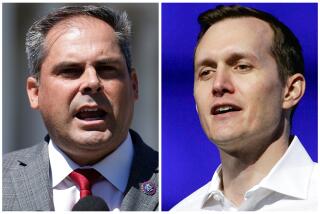Redistricting gives Latinos in East Valley a new opportunity
Reporting from Los Angeles and Washington â From his perch behind the counter at a storefront taqueria in Van Nuys, Isaac Perla has a ground-level view of the neighborhood. He looks out on streets lined with fruit vendors, stores selling elaborate quinceañera gowns, and billboards that are mostly in Spanish.
Like much of the east San Fernando Valley, Van Nuys is home to an increasing number of Latinos. And yet voters in the region have never sent a Latino representative to Congress, in part because the area is split into two congressional districts.
But change is afoot.
Maps approved Friday by the California Citizens Redistricting Commission show a new district with a strong Latino majority that stretches from North Hollywood to Sylmar.
The proposed 29th District would in effect replace the current 28th District, long the power center of Rep. Howard L. Berman of Valley Village. The boundary changes raise the Latino population from 57.5% in the old district to nearly 69% in the proposed new one.
Berman has said he plans to run in a neighboring district, leaving an open congressional seat. At least one Latino candidate has already announced plans to campaign for it, and political analysts expect others to follow.
Perla said he hopes one of them will win: âThere are some people who need help, and theyâre not going to get that from the people in charge now.â
Latino voters, he said, need politicians âwho look like them.â
When the commission embarked on the once-a-decade redrawing of Californiaâs voting districts â a task formerly performed by the state Legislature â minority groups lobbied to try to make sure they would be fairly represented.
And the East Valley was of particular concern to Latino activists, said Steven Ochoa, national redistricting coordinator for the Mexican American Legal Defense and Educational Fund.
After the 2001 redistricting, his organization filed a federal lawsuit claiming that officials had violated the Voting Rights Act by diluting the Latino vote when drawing boundaries for certain districts, including the 28th.
That challenge was unsuccessful. So over the last year, Ochoa and others crunched population numbers and presented the commission with their own proposed congressional map. The new boundary in the East Valley, Ochoa said, looks a lot like the one they proposed.
The new map speaks to the ever-growing political influence of Latinos in California politics, as well as to a major demographic shift.
The proposed 29th District encompasses Van Nuys â once home mostly to blue-collar whites, many of whom worked in the aerospace and automobile factories in the region â and Pacoima, which was one of the first large African American communities in the Valley.
But those areas have undergone a big transformation in recent decades, with many more Latinos moving in.
âThirty years ago, nobody would have thought about that area being a Latino seat,â said Bruce Cain, a UC Berkeley political scientist.
The new district, he said, is significant because it reflects the growth of Latino populations in more suburban neighborhoods.
âItâs not the growth in the inner-city areas; thatâs always been there,â he said. âThe big story â and the one that really upsets the Republicans â is the emergence of the suburban voting rights seats.â
Tony Cardenas hopes to capitalize on that.
Cardenas grew up in Pacoima, the youngest son of Mexican immigrants. He now represents the region on the Los Angeles City Council. Before that, he was the first Latino from the East Valley to be elected to the state Assembly.
In June, the redistricting commission released draft maps that showed the outline of the new Latino-heavy district â and Cardenas announced his plan to run for Congress.
More to Read
Sign up for Essential California
The most important California stories and recommendations in your inbox every morning.
You may occasionally receive promotional content from the Los Angeles Times.












